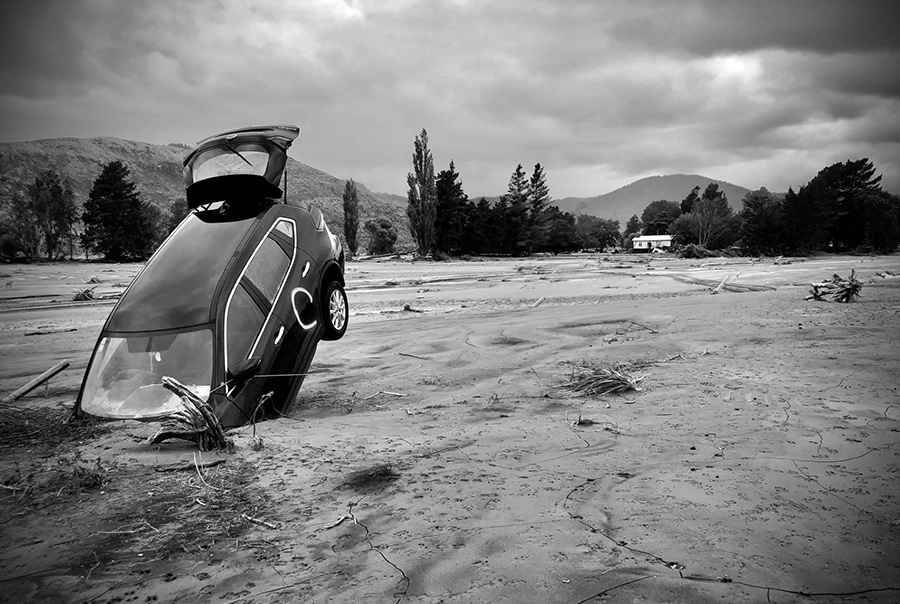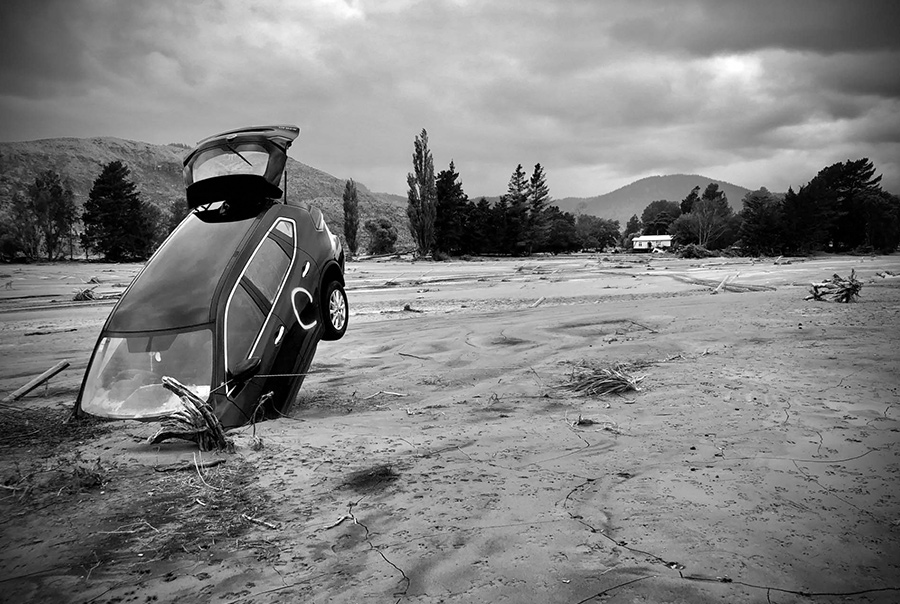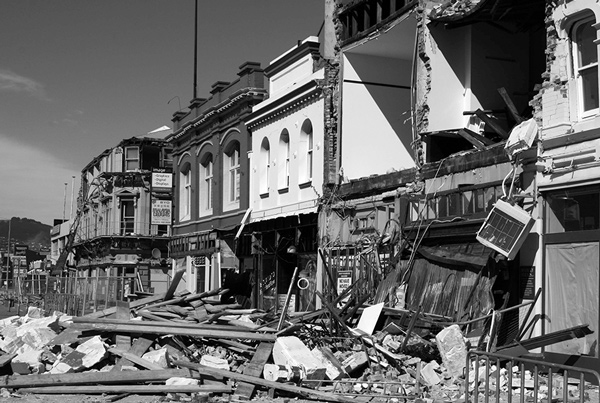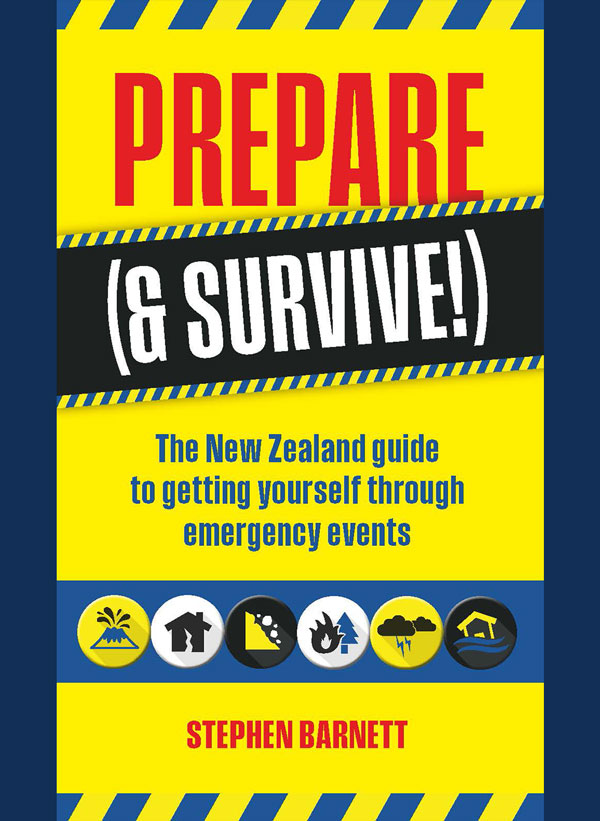

Alyse Hedley
Steve Braunias – The end is nigh
In Prepare (& Survive!), a new guide to getting through natural disasters and other apocalyptic events, well-meaning advice meets full-blown existential dread. Steve Braunias, deeply cynical and mildly horrified, reviews the handbook that wants to save your life — and your pets — but may just accelerate your anxiety
31st July 2025
The end is nigh, again. I am generally very anxious about the prospect of imminent death and specifically very anxious about a newly published handguide, Prepare (& Survive!): The New Zealand guide to getting yourself through emergency events. It has good intentions. It’s packed with information and advice on how to survive a range of natural disasters and other threats to your life and the lives of everyone around you–as well as your pets. Animal death toll from the Christchurch earthquakes: an estimated 3000 chickens, eight cows, one dog, a lemur and 150 aquarium fish.
But it’s a very annoying book. The author, Stephen Barnett, sometimes doesn’t seem to know whether he’s coming or going. In the event of a flood, he writes, move to higher ground. “But never try to walk, swim or drive through flood waters.” So don’t move to higher ground. Stay where you are. Please also stay where you are—okay you may not have much choice in the matter–if you are trapped beneath debris in an earthquake. “Try not to move or kick up dust as it could choke you.” And don’t shout for help in case you inhale dust. Solution: “Use a whistle.” Do you have a whistle on your person? Who walks around with a whistle? Phys ed teachers and referees shall inherit the Earth. The rest of us will succumb to floods and debris, unless we move fast. But not too fast. “In a tsunami, get inland as far as you can. Walk, run or cycle to reduce the chances of getting stuck in traffic.” Keep on walking. Ignore those piteous meows behind you. “Don’t spend time looking for pets, and if you’re not at home, don’t return to get them.” It’s always the lemurs that suffer.
There is such a fatalism about disaster narratives. It’s like the famous scene with Robert de Niro and Al Pacino in Heat, when de Niro’s character outlines his central philosophy: “Don’t let yourself get attached to anything you are not willing to walk out on in 30 seconds flat if you feel the heat around the corner.” The heat in his life was in the shape of cops wanting to take him down. The heat in your life are acts of God. Prepare (& Survive!) wants you to prepare for (& survive!) earthquake, flood, landslide, tsunami, wildfire, and volcanic activity (“Do not wear contact lenses as trapped ash can scratch your eyes”) along with something Barnett calls space weather: “The threat from solar flares is very real.” Whatever the problem is, the underlying message of his book is to act ruthlessly in 30 seconds flat. Do what you have to do to survive. Look out for Number 1. Save yourself. Individualism is paramount in a culture which celebrates free trade and self-reliance. Forget the cat, the dog, the aquarium fish: run.
It’s a vision of end times which just doesn’t seem very nice. Can’t we all just get along when we’re facing species extinction? History is abundant with good character references when disaster strikes. Wartime brings outs the best in people, even monsters. When Nazi Germany invaded Russia, and cut off supplies to Moscow, Stalin gave orders to hand out potatoes to the public at railway stations. Rodric Braithwaite’s excellent history Moscow 1941: A city and its people at war tells what happened next.
He writes, “People baked fritters from potato peelings they would previously have thrown away. You put the peelings through the mincer, and added water, flour, and salt. Or you grated the peelings, steamed them in water in a frying pan, and added crushed dried birch leaves instead of flour. You could make coffee from acorns. You cut the acorns in two, dried them on the stove, peeled them, boiled them in a saucepan with the lid on, and waited until the water was cold. Then you poured off the water, dried the acorns again, ground them, and added chicory or a bit of real coffee to give the taste. A spoonful of acorns was sufficient for one glass of coffee…In their window boxes people grew cucumbers and onions instead of flowers.”
That’s the kind of response to imminent death we should all aspire to. It sounds fun, a bit crazy, good for morale, something to do. Stephen Barnett, though, wants Kiwis to Prepare (& Survive!) to survive the worst and then die of boredom. He recommends putting aside supplies to last for a week, ideally a fortnight. “A couple of cardboard boxes stored at the back of a wardrobe will make a big difference should the time come. Do it.” The urgency of the italics leads to the world’s dreariest shopping list. He recommends filling the cardboard boxes with teabags, instant coffee, dried fruit, cereals, noodles, biscuits, rolled oats, duct tape, soap, towels, spare reading glasses, documents, can openers, cash, bottled water, a pack of cards and rapid glue setting.

Margaret Low.
He hurries though these contents but pauses to make a passionate speech about the merits of baked beans. “A 400g tin of baked beans can provide the basis of 2 nutritional meals. A dozen tins, then, is an emergency meal stash large enough to supply 2 people with 2 meals a day for a week. Baked beans –as with most canned food—can be eaten straight from the tin without needing to be heated. If you’re not keen on baked beans daily—and cold beans at that—it’s good to remember that they are a great source of protein and better than nothing in an emergency. They can be mixed into other foods such as rice or potatoes if you have those.”
The consequences of eating two dozen tins of baked beans day and night for a week may explain why Barnett gives such prominence to the longest single entry in his book: he devotes 12 pages to the art of making emergency toilets.
***
The thing about Prepare (& Survive!) that brings on the greatest anxiety is that it reminds me of my year of living preparedly, and what a disaster it was for everyone concerned.
I became very frightened that things were falling apart in the world and that I needed to step up to do everything I could to protect my family from peril. Some of it was brought on by fear of disruptive weather events caused by climate change, which is a very rational fear to have; some of it was inspired by world events, and the not entirely irrational fear of armed conflict having direct consequences for our way of life in New Zealand; but the deepest cause of it was taking a serious interest in the worldwide movement and philosophy of prepping, which was sometimes so irrational that it resembled insanity. I was good with that insanity. I signed onto that insanity. I couldn’t sleep some nights for fear of intruders breaking into the house and taking what they wanted to survive an apocalypse that was all in my own head.
I stocked up large. I spent thousands of dollars on assembling an even more boring shopping list than Barnett’s stockpile. I would spent weekends gloating over the contents, checking use-by dates against my chart, and making sure to refill bottled water. I bought a 200L rainwater tank. Just one, though. I became a member of Prep NZ, a lively, mostly good-natured online board devoted to the subject of preparing for end days, and marveled at one survivalist who wrote, “The Warehouse has 20L plastic water containers, buy 1, get 1 half-price, this weekend. So I bought 10. Got some very strange looks from the sheeple wandering around with their coke, junk food and Xbox games.”

Prepare (& Survive!)
I envied his commitment. I was jealous of the guy who shared what he did on his summer holidays: “I learned Morse code.” Another guy wrote, “Did some firearms training with my Crossman pistol in the back yard to teach my 10yr old son.” I envied his son. I wanted a gun, badly. I made inquiries. I knew people who knew people. I ended up meeting a go-between in a carpark in Panmure one night.
But what was it all about? What were the preppers preparing for? What, exactly, was the problem? It was just of naturally assumed things were going to go dark and that society would be torn apart, a massive systems failure leading to anarchy and Mad Max marauders. I took on their assumptions. The sleepless nights, the alertness I had for signs of forced entry—what made it worse is that I knew from Prep NZ that I was going about it the wrong way by only concentrating on wanting to turn my home into a fortress. Members emphasised the need to escape the city and hunker down in a cabin or bunker or somesuch secret “bug-out” location with their guns, their food, their diesel generator, their so-called Faraday cages which resist electrical magnetic pulses (EMPs) created by a nuclear blast. I had nowhere else to go.
And I worried that I was falling behind when it came down to whole lot of practical necessities. I read one prepping article headlined, “Forgotten Skills Every Prepper Should Learn.” The forgotten skills were butchering an animal, and tanning an animal hide. It’s always the lemurs that suffer.
Another post on the Prep NZ board listed “11 bad prepper strategies”. They included the notion of hunkering down in a city, and scavenging: “This is a terrible idea on so many levels it’s hard to know where to start.” It started by pointing out that there’d be nothing left to scavenge.
Something was going on in the world those days before Covid, some static interference. There was a general unease, a vaguely formed age of anxiety. I was losing my head while all around me others were losing their head even more. Around that time there was a false emergency alert in Hawaii that a nuclear strike was about to hit the island. According to the New York Times, “Within moments of the announcement, people crowded highways in scenes of terror and helplessness. Emergency sirens wailed in parts of the state, adding to the panic. ‘I was running through all the scenarios in my head, but there was nowhere to go, nowhere to pull over to,’ said Mike Staskow, a retired military captain.” Stephen Barnett was right: walk, run or cycle to reduce the chances of getting stuck in traffic. Matt LoPresti, a state representative, told CNN that he and his family headed for a bathroom: “I was sitting in the bathtub with my children, saying our prayers.” I watched a TV news reporter describe how he saw Hawaiians open a manhole, and put their children into storm drains.
Panic in the streets of Honolulu. Panic in one household in one street in Auckland…But the real threat to my family was not tsunami, earthquake, landslide, Mad Max or anything outside of the house. I was the threat. I wasn’t worth living with anymore. All the emergency supplies were maybe just some sort of weird attempt to cover it up. There was a break-up, and I stayed where I was, suddenly losing all interest in prepping and waiting for the worst to happen. It had already happened.
I found the emergency supplies when we sold the house a few years later. All the food had passed its use-by date. But there was still quite a lot worth keeping, things like rubber gloves, rope, twine, pegs, a transistor, first aid kit, rubber bags, buckets with tightly fitting lids (essential for an emergency toilet)….I have it stored in the shed. Prepare (& Survive!) is a good reminder to replenish it with food and water. We all should. To repeat Stephen Barnett’s advice, “A couple of cardboard boxes stored at the back of a wardrobe will make a big difference should the time come. Do it.” No italics this time. No rush, no urgency. Find the time, maybe make it a fun thing to do. Be resourceful. Cherish the moment. There are a million ways to die but you only live once.
